Cookbook #227: Mastering the Art of French Cooking, Julia Child, Louisette Bertholle, Simone Beck, Borzoi Books, Alfred A. Knopf, NY, 1961. Thirtieth Printing, June, 1978.
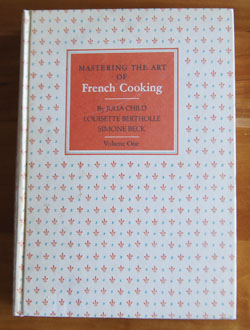
“Julie & Julia”, the 2009 film starring Meryl Streep and Amy Adams, portrays the true story of Julie Powell, a young New Yorker who took on the challenge of cooking all 524 recipes in Mastering the Art of French Cooking. She covered her experiences in a blog, and eventually a book: Julie and Julia: 365 Days, 524 Recipes, 1 Tiny Apartment Kitchen. When the movie came out, I ran upstairs to see if I had a copy of Mastering the Art of French Cooking. And yes, it was on my bookshelf!
Mastering the Art of French Cooking always intimidated me. My copy is barely wrinkled, no food stains mar the pages. In the past, no more did I want to read it that I would want to read a book on advanced physical chemistry.
I’ve grown up a bit though, and taken a class on classic French sauces. I’ve also learned how to make my own great stocks. I’ll say “I am wiser”, and am feeling this especially this week because I just turned a year older. Now as I turn the pages of Mastering the Art of French Cooking, I can understand the language and appreciate the wisdom, and I smile warmly at Julia Child’s complete love of cooking.
On my birthday this week, I got up late and decided to make an omelet. And I don’t just mean “make an omelet”, I wanted to make an omelet according to Julia’s directions. I wanted nothing else for breakfast! Just an experiment. It was, afterall, my birthday.
I open Mastering the Art of French Cooking to page 127. Julia Child says it will only take 30 seconds to make the omelette. And, “An omelette cannot be made in a sticky pan. The eggs must be able to slide around freely. This is why it is a good idea to have one pan that is reserved for omelettes only.” And the type of pan Julia Child likes the best? The French type of plain iron pan with sloping sides. Aha, I own just such a pan! I got it about a year ago. But I banished it to the basement because it is so heavy and hard to clean.
Today I jog down to the basement and retrieve the pan. I scrub it with steel wool and soap, dry it carefully, and heat it to get all the water off. Then I rub it with oil and wipe all that off. I set it on the stove.
“The individual 2- to 3-egg omelette is usually the tenderest, and by far the best size to practice making.” Perfect. “Just before heating the butter in the pan, break the eggs into a mixiing bowl and add salt and pepper. With a large table fork, beat the eggs only enough to blend the whites and yolks thoroughly. From 30 to 40 vigorous strokes should be sufficient.”
My 3 eggs mixed with 30 vigorous strokes, it’s time to heat my pan. “Place the butter [1 tablespoon] in the pan and set over very high heat . . . as the butter melts, tilt the pan in all directions to film the sides. When you see that the foam has almost subsided in the pan and the butter is on the point of coloring, it is an indication that it is hot enough to pour in the eggs.”
Next comes the short but busy omelette-cooking step. I am to hold the (heavy) pan in my left hand, pour in the eggs, and immediately start sliding the pan back and forth rapidly over the heat. And at the same time, I am supposed to stir the eggs with the bottom flat side of a fork to spread them all over the bottom of the pan. In only 3 or 4 seconds, the eggs will become a light custard, and it will be time to tilt the pan at a 45 degree angle and gather the eggs at the far lip of the pan. And give “4 or 5 sharp blows on the handle of the pan with your right fist to loosen the omelette and make the far edge curl over onto itself.”
This all happened very fast. But somehow, I poured a creamy, soft roll of eggs onto a plate. No toast, no coffee cake, no sausage, just eggs. I immediately take the hot omelette and two forks and sit down next to my husband. He gives me this look, as if, he is supposed to share this with me? “It’s my birthday, I can do what I want!”
I took the first bite and . . . heavenly tastes and textures burst in my mouth. Dang that was a great omelette. Thank you Julia Child!
I spend several days paging through Mastering the Art of French Cooking. I took lots of notes! I really do like this classic cookbook. I suggest every serious cook buy or borrow a copy at some point in their life.
The only drawback to Julia Child’s recipes is the heavy use of butter, cream, and egg yolks. Yes, I have read The Big Fat Surprise, a book that disputes the generally accepted idea that the fats in these foods are bad for you, and instead encourages us to include them in our diet. But still, calories are calories, and stick on my body as weight when I eat too many. Just saying.
But this week, I will indulge in a Julia Child recipe: Filets de Poisson Gratinés, à la Parisienne, or “Fish Filets Poached in White Wine; Cream and Egg Yolk Sauce.” This recipe is a great example of Julia Child’s presentation style.
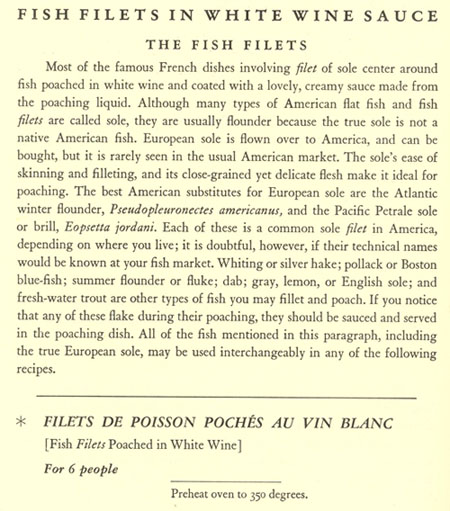
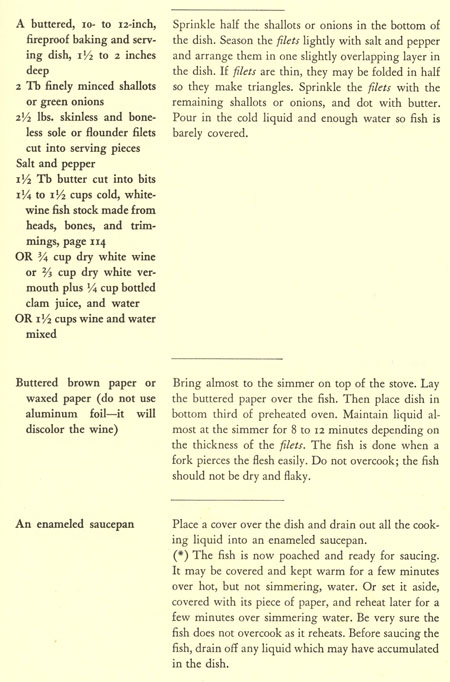

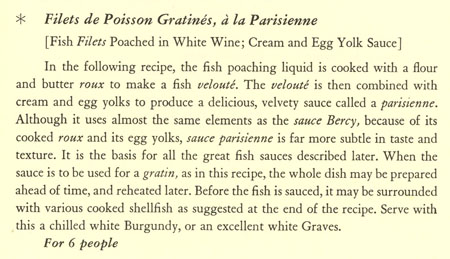
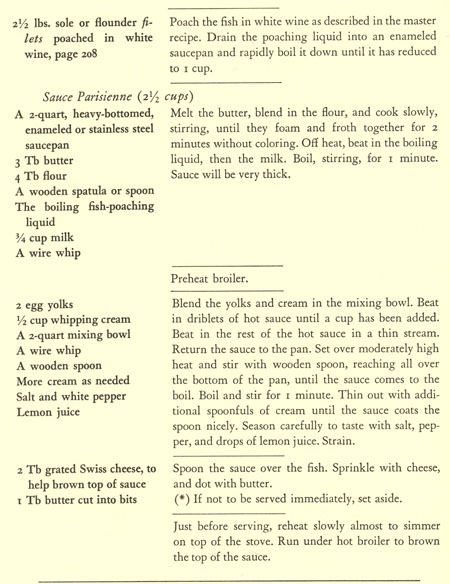
Below is my adaptation of this recipe. Note that you need a baking dish that you can heat on the stove top and also place in the oven. I used a LeCreuset.
Poached Sole in Velouté Sauce
serves 2
Poaching the fish:
- 1 pound sole filets
- 1 tablespoon minced shallots
- butter: you need this throughout; I used unsalted butter, less than a cube in all
- salt and pepper
- 1/2 cup fish stock (or use water)
- 1/2 cup white wine
- a piece of parchment cut to fit the LeCreuset
Turn on the oven to 350˚.
Butter the bottom of a LeCreuset. Sprinkle in half the minced shallots. Season the sole filets with salt and pepper, then place in the prepared LeCreuset, slightly overlapping the filets. Dot with 3/4 tablespoon butter cut into small chunks. Combine the fish stock and the wine and pour over the fish. Add a little more stock if necessary to barely cover the fish. Mine looked like this:

On the stovetop, bring the fish almost to simmering. Butter both sides of the piece of parchment. Place the LeCreuset in the 350˚ oven. Bake for 8 minutes, check for doneness by piercing with a fork (you should find just a slight resistance), and bake a few more minutes only if necessary. During the baking, the cooking liquid should be at a light simmer.
Drain the cooking liquid into a small saucepan, leaving the poached fish in the LeCreuset, covered with the parchment.
Boil the cooking liquid until it is reduced to 1/2 cup. This will be use in the sauce.
Veloute Sauce:
- 1 1/2 tablespoons butter
- 2 tablespoons flour
- 1/2 cup reduced cooking liquid (hot)
- 3/8 cup milk
- 1 egg yolk
- 1/4 cup cream
- “drops” of lemon juice
- 1/2 tablespoon butter
- 1 tablespoon grated Swiss cheese
Melt the 1 1/2 tablespoons butter in a small sauce pan, then add the flour and stir until it is all mixed in. Continue cooking until it thickens but do not cook it until it browns. Off heat, beat in the hot cooking liquid and the milk. A whisk works well for this step. Put the pan back on the stove and bring to a boil, stirring constantly. Boil about a minute – the mixture will be thick.
In a bowl, blend the egg yolk with the cream, using a whisk. Add small amounts of the hot sauce and continue beating until about 1/2 cup of the hot sauce is added, then add the rest of the hot sauce in a thin stream. Put the mixture back in the pan and boil and stir 1 minute. You can thin with a little cream if it is too thick for your tastes. Add a few drops of lemon juice and salt and pepper.
Preheat the broiler.
Spoon the sauce over the poached fish (take the parchment off first), then dot the top with the 1/2 tablespoon butter and the Swiss cheese. On the stove top, over low heat, heat until it is just simmering.
Put the dish under the broiler until the top of the sauce is brown.
What is nice about this dish is that you can assemble it with the poached fish covered with sauce, and then do the stove-top heating and broiling steps just before serving. It’s important to bring this dish to the table hot and bubbly.
Here is the plated dish.
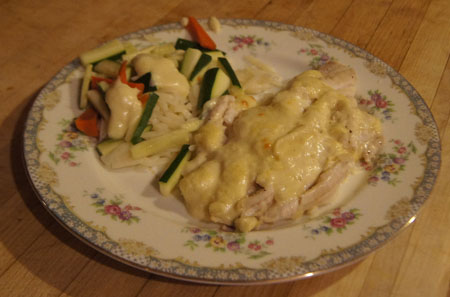 I served with a little orzo and steamed julienned zucchini and carrots on the side. I also served a loaf of my own no-knead bread. And a couple pretty green salads. For dessert? Fresh blackberries over ice cream.
I served with a little orzo and steamed julienned zucchini and carrots on the side. I also served a loaf of my own no-knead bread. And a couple pretty green salads. For dessert? Fresh blackberries over ice cream.
I took my first bite of the fish and then I had to set down my fork so I wouldn’t gobble up the rest too fast. This is absolutely delicious! “One of the best twenty-five meals ever in my life” was my comment.
Thank you Julia Child.
